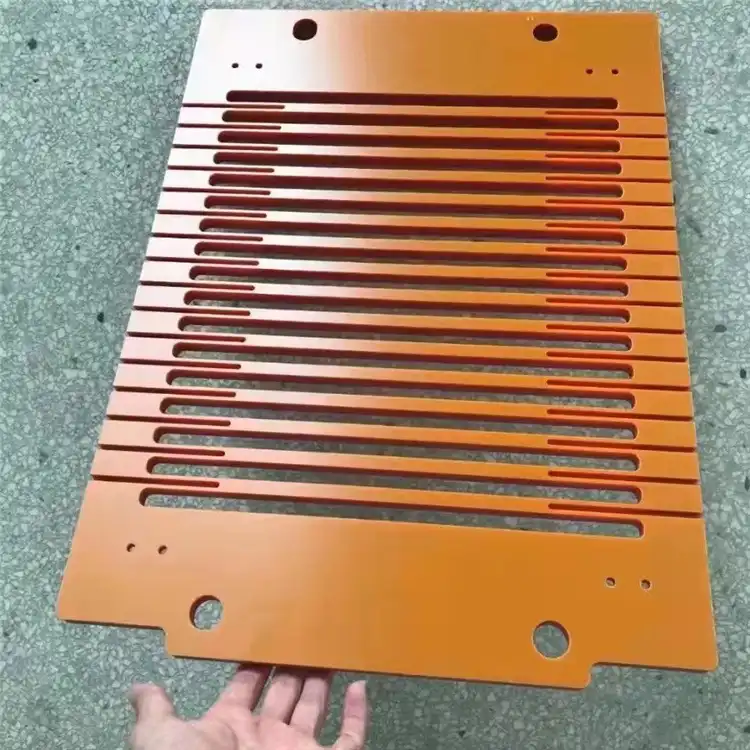Understanding Bakelite Sheet Properties
Composition and Structure of Bakelite
Bakelite, a pioneering synthetic plastic, boasts a unique composition that contributes to its remarkable properties. This thermosetting phenol formaldehyde resin is formed through a complex polymerization process, resulting in a dense, cross-linked molecular structure. The intricate network of phenol and formaldehyde molecules creates a material that is not only durable but also resistant to heat, electricity, and chemicals. The molecular arrangement of Bakelite is key to understanding its behavior in various environments, including its interaction with water molecules.
Chemical Resistance of Bakelite Sheet
One of the hallmarks of Bakelite board is its impressive chemical resistance. This attribute stems from its stable molecular structure, which remains largely unaffected by a wide range of chemicals. Bakelite board's resistance extends to acids, alkalis, and many organic solvents, making it a versatile material in industrial applications. However, it's important to note that while Bakelite board exhibits broad chemical resistance, its interaction with water is more nuanced. The material's response to aqueous environments is influenced by factors such as exposure time, temperature, and the specific formulation of the Bakelite sheet.
Thermal and Electrical Properties
Bakelite's thermal and electrical properties further contribute to its performance in moist environments. The material maintains its structural integrity across a wide temperature range, resisting deformation and degradation. This thermal stability is particularly beneficial in applications where water exposure may occur at varying temperatures. Electrically, Bakelite serves as an excellent insulator, a property that remains largely unaffected by moderate moisture exposure. The combination of thermal resistance and electrical insulation makes Bakelite sheet a preferred choice in environments where both water resistance and electrical safety are paramount.
Water Resistance Characteristics of Bakelite Sheet
Moisture Absorption Rates
The water resistance of Bakelite sheet is primarily characterized by its low moisture absorption rates. When exposed to humid conditions or direct water contact, Bakelite exhibits a minimal tendency to absorb moisture. This property is quantified through standardized tests that measure weight gain after immersion or exposure to high humidity environments. Typical Bakelite formulations show moisture absorption rates significantly lower than many other plastics and natural materials. However, it's crucial to understand that while the absorption rate is low, it is not zero, indicating that Bakelite is water-resistant rather than completely waterproof.
Surface Wettability and Contact Angle
The interaction between water and Bakelite sheet at the surface level is another critical aspect of its water resistance. Surface wettability, often measured by the contact angle of water droplets on the material, provides insights into how Bakelite repels or attracts water. Bakelite typically exhibits a relatively high contact angle, indicating a hydrophobic nature. This property means that water tends to bead up on the surface rather than spreading out, enhancing the material's ability to resist water penetration. However, factors such as surface roughness, contamination, and aging can affect this characteristic over time.
Long-term Effects of Water Exposure
While Bakelite sheet demonstrates excellent short-term water resistance, the long-term effects of prolonged water exposure warrant consideration. Extended contact with water, especially under conditions of elevated temperature or pressure, can gradually impact the material's properties. Over time, minute amounts of water absorption may occur, potentially leading to subtle changes in dimensions, weight, or mechanical properties. Additionally, cyclic exposure to wet and dry conditions can induce stress in the material, potentially affecting its surface quality or structural integrity in extreme cases. Understanding these long-term effects is crucial for applications where Bakelite sheet is expected to perform in water-prone environments over extended periods.
Applications and Considerations for Water-Resistant Bakelite
Industrial Applications Leveraging Water Resistance
Bakelite board’s water-resistant properties make it an invaluable material in numerous industrial applications. In the electrical industry, Bakelite board serves as an insulating material for components exposed to humid environments, ensuring safety and reliability. Marine applications benefit from Bakelite's ability to withstand saltwater exposure, making it suitable for instrument panels and electrical enclosures on ships. In chemical processing plants, Bakelite sheet is utilized for lining tanks and pipes, where its chemical and water resistance are paramount. The automotive sector employs Bakelite in various under-hood components, leveraging its ability to maintain integrity in the presence of moisture and heat.
Enhancing Water Resistance through Surface Treatments
While Bakelite sheet inherently possesses good water resistance, various surface treatments can further enhance this property. Hydrophobic coatings, such as fluoropolymer-based solutions, can be applied to Bakelite surfaces to increase their water repellency. These treatments modify the surface energy of the material, causing water to bead up and roll off more readily. Another approach involves the application of sealants or barrier coatings that provide an additional layer of protection against water ingress. Some manufacturers also offer Bakelite sheets with specially formulated surfaces that exhibit improved water resistance without the need for post-production treatments.
Design Considerations for Water-Resistant Applications
When incorporating Bakelite sheet into designs where water resistance is crucial, several factors must be considered. The geometry of the component plays a significant role in its ability to shed water and prevent pooling. Designers should avoid creating areas where water can accumulate and potentially penetrate the material over time. Edge sealing is another critical consideration, as exposed edges may be more susceptible to water absorption than the sheet's surface. In applications where complete waterproofing is necessary, designers may need to incorporate additional measures such as gaskets or O-rings at joints and interfaces. Furthermore, the method of fastening or joining Bakelite components should be carefully considered to maintain the integrity of the water-resistant system.
Conclusion
In conclusion, while Bakelite sheet is not completely waterproof, its impressive water-resistant properties make it a reliable choice for numerous applications where moisture protection is crucial. Its low moisture absorption rates, chemical resistance, and stability in various environments contribute to its enduring popularity in industrial and commercial sectors. By understanding the nuances of Bakelite's interaction with water and implementing appropriate design strategies, engineers and manufacturers can effectively leverage this versatile material in water-prone settings. As technology advances, ongoing research continues to enhance the water-resistant capabilities of Bakelite, ensuring its relevance in an ever-evolving industrial landscape.
Contact Us
For more information about our high-quality Bakelite sheets and how they can meet your specific water-resistant needs, please don't hesitate to contact us. Our team of experts is ready to assist you in finding the perfect solution for your application. Reach out to us at info@jhd-material.com to discuss your requirements or to request a quote. Let's work together to enhance your projects with the superior properties of Bakelite.






